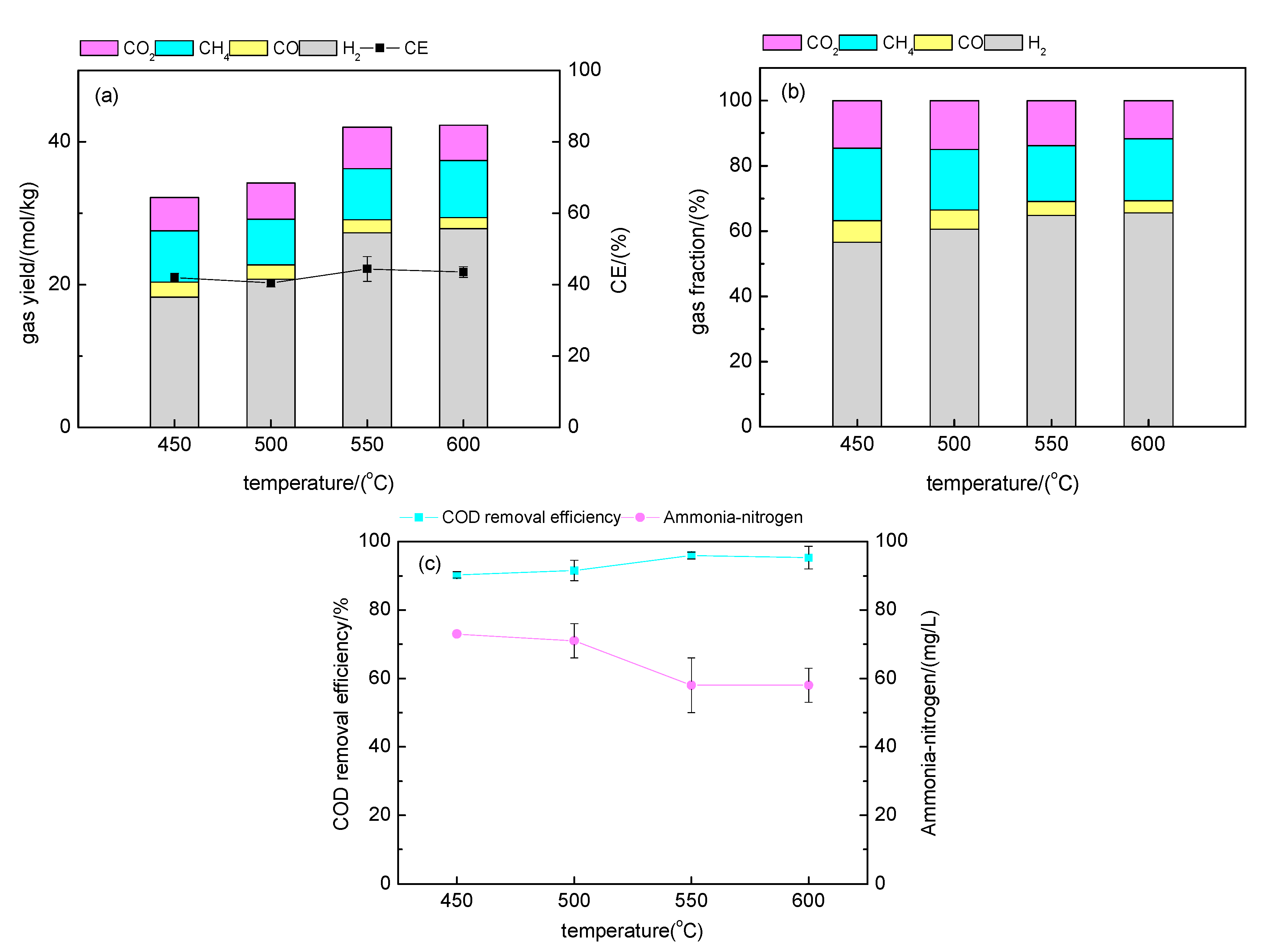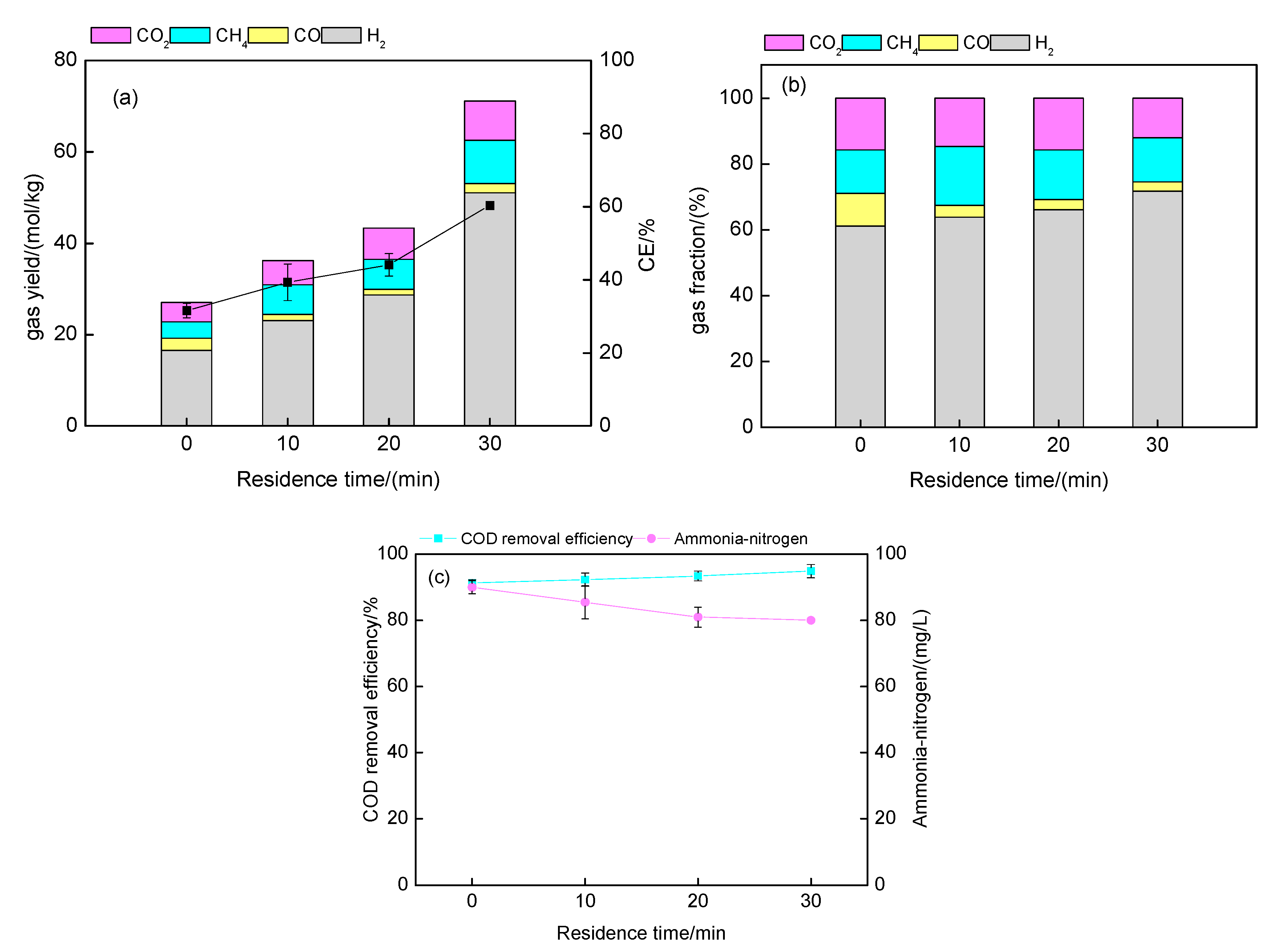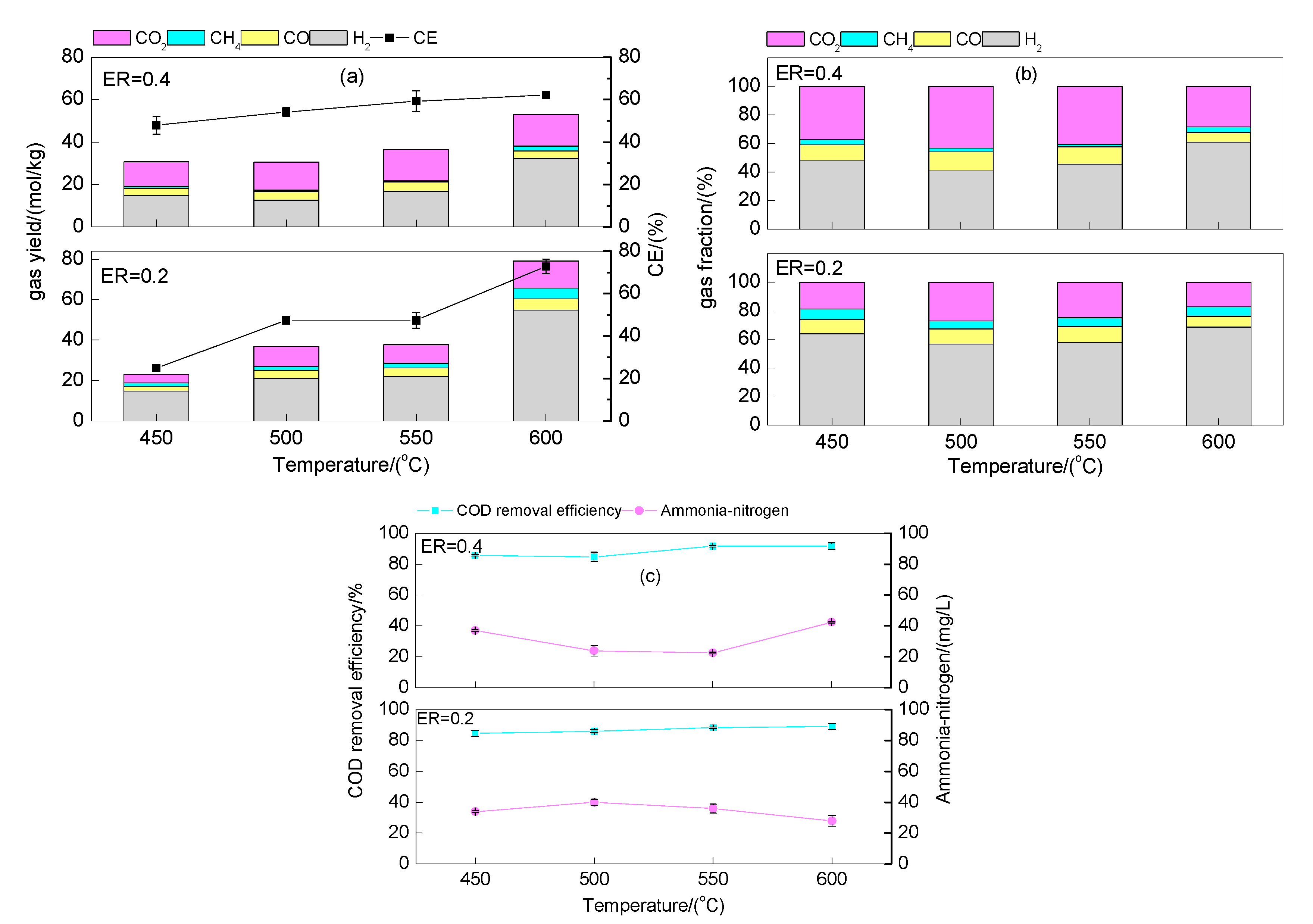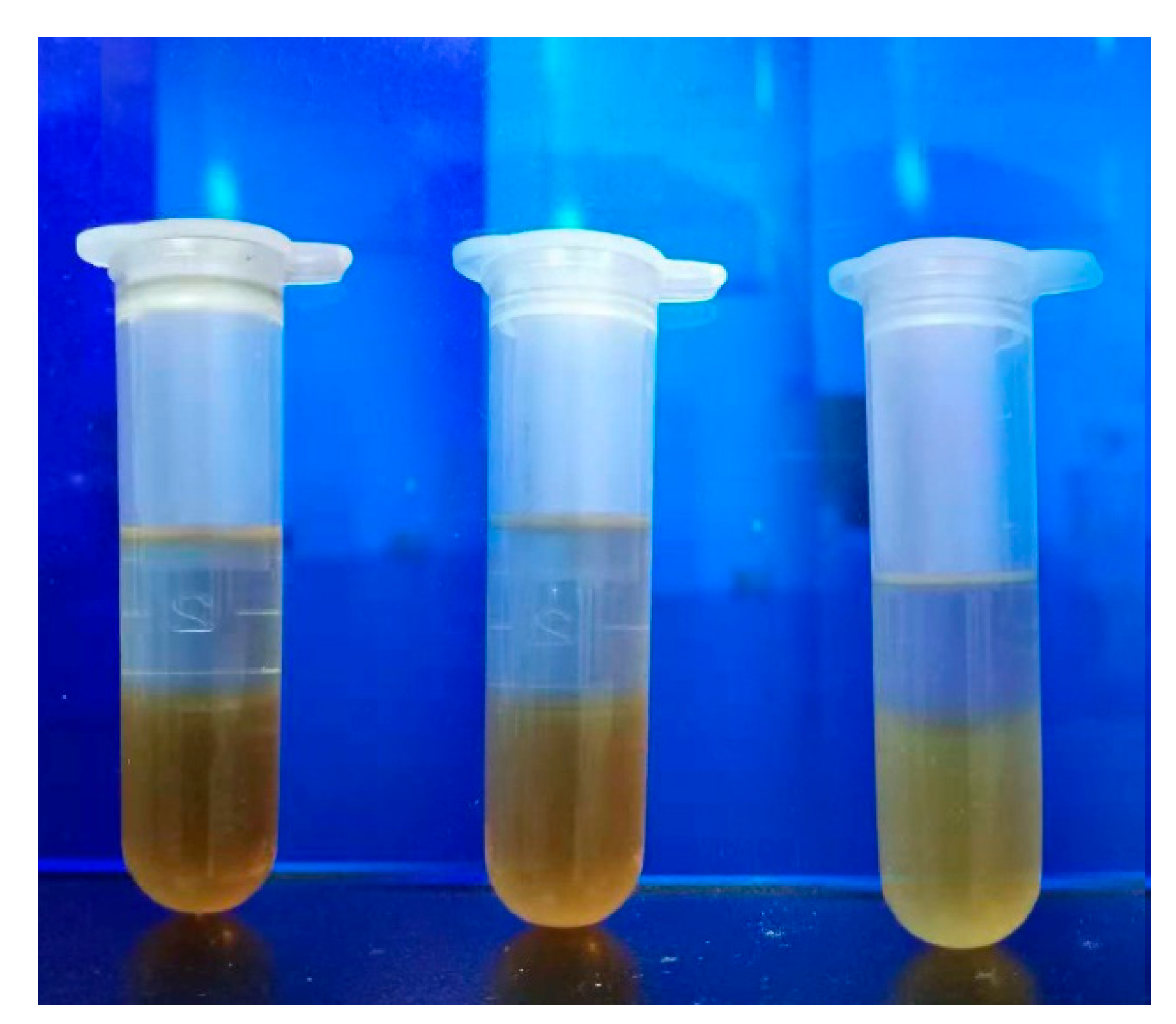Study on Hydrogen Production by Supercritical Water Gasification of Unsymmetrical Dimethylhydrazine under Multi-Parameters
Abstract
:1. Introduction
2. Experiment
2.1. Apparatus and Methods
2.2. Analysis Methods
3. Results and Discussion
3.1. Effect of Temperature
3.2. Effect of Catalyst
3.3. Effect of Residence Time
3.4. Effect of Oxidant and ER
3.5. Reaction Mechanism
4. Conclusions
- (1)
- Gas efficiency can be promoted with the addition of an alkaline catalyst and KOH owned the highest gas efficiency. The maximum molar fraction and yield of hydrogen reached 87.0% and 97.9 mol/kg, respectively, with KOH at 550 °C, 23 MPa, and a residence time of 20 min.
- (2)
- The COD removal efficiency reached 95% at 600 °C, 23 MPa, no catalyst added, and a residence time of 30 min. When ER was 0.4, the ammonia nitrogen concentration of the residual liquid can meet the requirement of the Chinese emission standard of water pollution for space propellant, which is 25 mg/L.
- (3)
- When the concentration of UDMH solution is up to 50 wt%, the major degradation product under low temperature is trimethylamine (TMA) whose relative amount has a reduction tendency as the temperature increases.
Author Contributions
Funding
Data Availability Statement
Conflicts of Interest
Nomenclature
| CE | the mass of carbon in gaseous product/the mass of carbon in UDMH ×100, % |
| YH2 | the molar number of produced hydrogen/the mass of UDMH, mol/kg |
| Gas fraction | the molar number of a certain gas product/the summation of the molar number of all the gaseous product ×100, % |
| ER | the mass of oxidation added/the mass of oxidant for complete oxidation of UDMH by stoichiometry calculation |
References
- Salvador, C.A.V.; Costa, F.S. Vaporization lengths of hydrazine fuels burning with NTO. J. Propuls. Power 2006, 22, 1362–1372. [Google Scholar] [CrossRef]
- Fedorov, L.A. Liquid missile propellants in the former Soviet Union. Environ. Pollut. 1999, 105, 157–161. [Google Scholar]
- Tamura, T.; Shibutani, M.; Toyoda, K.; Shoda, T.; Takada, K.-I.; Uneyama, C.; Takahashi, M.; Hirose, M. Tumor-promoting activities of hydroquinone and 1,1-dimethylhydrazine after initiation of newborn mice with 1-methyl-1-nitrosourea. Cancer Lett. 1999, 143, 71–80. [Google Scholar] [CrossRef]
- Carlsen, L.; Kenesova, O.A.; Batyrbekova, S.E. A preliminary assessment of the potential environmental and human health impact of unsymmetrical dimethylhydrazine as a result of space activities. Chemosphere 2007, 67, 1108–1116. [Google Scholar] [CrossRef]
- Yi, L.; Guo, L.; Jin, H.; Kou, J.; Zhang, D.; Wang, R. Gasification of unsymmetrical dimethylhydrazine in supercritical water: Reaction pathway and kinetics. Int. J. Hydrogen Energy 2018, 43, 8644–8654. [Google Scholar] [CrossRef]
- Savage, P.E. Organic Chemical Reactions in Supercritical Water. Chem. Rev. 1999, 99, 603–622. [Google Scholar] [CrossRef]
- Watanabe, M.; Sato, T.; Inomata, H.; Smith, R.L.; Arai, K.; Kruse, A.; Dinjus, E. Chemical reactions of C-1 compounds in near-critical and supercritical water. Chem. Rev. 2004, 104, 5803–5821. [Google Scholar] [CrossRef]
- Loppinet-Serani, A.; Aymonier, C.; Cansell, F. Current and Foreseeable Applications of Supercritical Water for Energy and the Environment. Chemsuschem 2008, 1, 486–503. [Google Scholar] [CrossRef]
- Guo, L.J.; Jin, H. Boiling coal in water: Hydrogen production and power generation system with zero net CO2 emission based on coal and supercritical water gasification. Int. J. Hydrog. Energy 2013, 38, 12953–12967. [Google Scholar] [CrossRef]
- Guo, L.; Jin, H.; Ge, Z.; Lu, Y.; Cao, C. Industrialization prospects for hydrogen production by coal gasification in supercritical water and novel thermodynamic cycle power generation system with no pollution emission. Sci. China-Technol. Sci. 2015, 58, 1989–2002. [Google Scholar] [CrossRef]
- Christian, P.; Giles, M.R.; Howdle, S.M.; Major, R.C.; Hay, J.N. The wall effect: How metal/radical interactions can affect polymerisations in supercritical carbon dioxide. Polymer 2000, 41, 1251–1256. [Google Scholar] [CrossRef]
- Yu, D.H.; Aihara, M.; Antal, M.J. Hydrogen-Production by Steam Reforming Glucose In Supercritical Water. Energy Fuels 1993, 7, 574–577. [Google Scholar] [CrossRef]
- Zhu, C.; Wang, R.; Jin, H.; Lian, X.; Guo, L.; Huang, J. Supercritical water gasification of glycerol and glucose in different reactors: The effect of metal wall. Int. J. Hydrogen Energy 2016, 41, 16002–16008. [Google Scholar] [CrossRef]
- Lan, R.; Jin, H.; Guo, L.; Ge, Z.; Guo, S.; Zhang, X. Hydrogen Production by Catalytic Gasification of Coal in Supercritical Water. Energy Fuels 2014, 28, 6911–6917. [Google Scholar] [CrossRef]
- Dileo, G.J.; Neff, M.E.; Savage, P.E. Gasification of guaiacol and phenol in supercritical water. Energy Fuels 2007, 21, 2340–2345. [Google Scholar] [CrossRef]
- DiLeo, G.J.; Savage, P.E. Catalysis during methanol gasification in supercritical water. J. Supercrit. Fluids 2006, 39, 228–232. [Google Scholar] [CrossRef]
- Resende, F.L.P.; Savage, P.E. Expanded and Updated Results for Supercritical Water Gasification of Cellulose and Lignin in Metal-Free Reactors. Energy Fuels 2009, 23, 6213–6221. [Google Scholar] [CrossRef]
- Guo, S.; Guo, L.; Yin, J.; Jin, H. Supercritical water gasification of glycerol: Intermediates and kinetics. J. Supercrit. Fluids 2013, 78, 95–102. [Google Scholar] [CrossRef]
- Bühler, W.; Dinjus, E.; Ederer, H.; Kruse, A.; Mas, C. Ionic reactions and pyrolysis of glycerol as competing reaction pathways in near- and supercritical water. J. Supercrit. Fluids 2002, 22, 37–53. [Google Scholar] [CrossRef]
- Guo, Y.; Wang, S.; Xu, D.; Gong, Y.; Ma, H.; Tang, X. Review of catalytic supercritical water gasification for hydrogen production from biomass. Renew. Sustain. Energy Rev. 2010, 14, 334–343. [Google Scholar] [CrossRef]
- Lu, Y.; Jin, H.; Guo, L.; Zhang, X.; Cao, C.; Guo, X. Hydrogen production by biomass gasification in supercritical water with a fluidized bed reactor. Int. J. Hydrogen Energy 2008, 33, 6066–6075. [Google Scholar] [CrossRef]
- Kruse, A. Hydrothermal biomass gasification. J. Supercrit. Fluids 2009, 47, 391–399. [Google Scholar] [CrossRef]
- Tang, H.Q.; Kitagawa, K. Supercritical water gasification of biomass: Thermodynamic analysis with direct Gibbs free energy minimization. Chem. Eng. J. 2005, 106, 261–267. [Google Scholar] [CrossRef]
- Cao, C.; Guo, L.; Jin, H.; Guo, S.; Lu, Y.; Zhang, X. The influence of alkali precipitation on supercritical water gasification of glucose and the alkali recovery in fluidized-bed reactor. Int. J. Hydrogen Energy 2013, 38, 13293–13299. [Google Scholar] [CrossRef]
- Guo, S.M.; Guo, L.; Cao, C.; Yin, J.; Lu, Y.; Zhang, X. Hydrogen production from glycerol by supercritical water gasification in a continuous flow tubular reactor. Int. J. Hydrogen Energy 2012, 37, 5559–5568. [Google Scholar] [CrossRef]
- Weijin, G.; Binbin, L.; Qingyu, W.; Zuohua, H.; Liang, Z. Supercritical water gasification of landfill leachate for hydrogen production in the presence and absence of alkali catalyst. Waste Manag. 2018, 73, 439. [Google Scholar] [CrossRef] [PubMed]
- Chen, Y.; Guo, L.; Cao, W.; Jin, H.; Guo, S.; Zhang, X. Hydrogen production by sewage sludge gasification in supercritical water with a fluidized bed reactor. Int. J. Hydrogen Energy 2013, 38, 12991–12999. [Google Scholar] [CrossRef]
- Kruse, A. Supercritical water gasification. Biofuels Bioprod. Biorefining 2008, 2, 415–437. [Google Scholar] [CrossRef]
- Jin, H.; Lu, Y.; Guo, L.; Zhang, X.; Pei, A. Hydrogen Production by Supercritical Water Gasification of Biomass with Homogeneous and Heterogeneous Catalyst. Adv. Condens. Matter Phys. 2014, 2014, 160565. [Google Scholar] [CrossRef]
- Lunn, G.; Sansone, E.B. Oxidation of 1,1-dimethylhydrazine (UDMH) in aqueous solution with air and hydrogen peroxide. Chemosphere 1994, 29, 1577–1590. [Google Scholar] [CrossRef]
- Tuazon, E.C.; Carter, W.P.L.; Winer, A.M.; Pitts, J.N. Reactions of hydrazines with ozone under simulated atmospheric conditions. Environ. Sci. Technol. 1981, 15, 823–828. [Google Scholar] [CrossRef]
- Pestunova, O.P.; Elizarova, G.L.; Ismagilov, Z.R.; Kerzhentsev, M.A.; Parmon, V.N. Detoxication of water containing 1, 1-dimethylhydrazine by catalytic oxidation with dioxygen and hydrogen peroxide over Cu-and Fe-containing catalysts. Catal. Today 2002, 75, 219–225. [Google Scholar] [CrossRef]
- Mathur, M.A.; Sisler, H.H. Oxidation of 1,1-dimethylhydrazine by oxygen. Inorg. Chem. 1981, 20, 426–429. [Google Scholar] [CrossRef]
- Abilev, M.; Kenessov, B.; Batyrbekova, S.; Grotenhuis, T. Chemical oxidation of unsymmetrical dimethylhydrazine transformation products in water. Prog. Brain Res. 2015, 148, 321–328. [Google Scholar] [CrossRef]
- Guo, L.J.; Lu, Y.J.; Zhang, X.M.; Ji, C.M.; Guan, Y.; Pei, A.X. Hydrogen production by biomass gasification in supercritical water: A systematic experimental and analytical study. Catal. Today 2007, 129, 275–286. [Google Scholar] [CrossRef]
- Katritzky, A.R.; Shipkova, P.A.; Allin, S.M.; Barcock, R.A.; Siskin, M.; Olmstead, W.N. Aqueous High-Temperature Chemistry. 24. Nitrogen-Containing Heterocycles in Supercritical Water at 460 °C. Energy Fuels 1995, 9, 580–589. [Google Scholar] [CrossRef]





| Component | Feed | Product |
|---|---|---|
| UDMH | 0.00029997 1 | 0 |
| H2O | 0.9997 | 0.9967211 |
| H2 | 0 | 0.00237643 |
| CO | 0 | 2.98 × 10−7 |
| CH4 | 0 | 1.59 × 10−6 |
| CO2 | 0 | 0.000596985 |
| C2H4 | 0 | 3.77 × 10−18 |
| C2H6 | 0 | 6.62 × 10−15 |
| N2 | 0 | 0.000295299 |
| NH3 | 0 | 8.27 × 10−6 |
| N2O | 0 | 1.22 × 10−26 |
| NO2 | 0 | 1.08 × 10−34 |
| RT (min) | Name | Chemical Formula | Structural Formula | 400 °C | 450 °C | 500 °C |
|---|---|---|---|---|---|---|
| Area % | ||||||
| 1.430 | Trimethylamine | C3H9N |  | 35.184 | 16.396 | 17.477 |
| 1.527 | Ethanamine, N,N-dimethyl- | C4H11N |  | 4.411 | 1.133 | 2.504 |
| 2.168 | Aziridine, 1,2,3-trimethyl-, trans- | C5H11N |  | 2.753 | - | - |
| 5.465 | Propanenitrile | C3H5N |  | 1.016 | 1.784 | 4.049 |
| 5.642 | Propanal, 2-methyl-, dimethylhydrazone | C6H14N2 |  | 1.098 | 8.128 | 1.327 |
| 7.071 | Butanenitrile, 2-methyl- | C5H9N |  | 0.764 | 0.826 | 0.466 |
| 8.963 | 1H-Pyrrole, 1-methyl- | C5H7N |  | 2.118 | 1.060 | - |
| 10.272 | Pyridine | C5H5N |  | 1.348 | 1.579 | 0.542 |
| 11.626 | 1H-Pyrrole, 2,5-dimethyl- | C6H9N |  | 2.186 | 1.754 | 2.262 |
| 13.124 | 1H-Pyrazole, 1-methyl- | C4H6N2 |  | 8.778 | 8.242 | 5.871 |
| 14.627 | Pyridine,3-methyl- | C6H7N |  | 8.659 | 11.191 | 14.148 |
| 17.130 | Pyrazole, 1,4-dimethyl- | C5H8N2 |  | 12.790 | 10.653 | 5.218 |
| 19.931 | Pyridine, 3,5-dimethyl- | C7H9N |  | 8.983 | 13.135 | 13.581 |
| 33.956 | 1H-Pyrrole, 2,3,4,5-tetramethyl- | C8H13N |  | 9.913 | 24.117 | 32.555 |
Publisher’s Note: MDPI stays neutral with regard to jurisdictional claims in published maps and institutional affiliations. |
© 2022 by the authors. Licensee MDPI, Basel, Switzerland. This article is an open access article distributed under the terms and conditions of the Creative Commons Attribution (CC BY) license (https://creativecommons.org/licenses/by/4.0/).
Share and Cite
Yi, L.; Chen, J.; Liu, Z.; Chen, H.; Liu, D.; Liu, Z.; Chen, B. Study on Hydrogen Production by Supercritical Water Gasification of Unsymmetrical Dimethylhydrazine under Multi-Parameters. Energies 2022, 15, 7081. https://doi.org/10.3390/en15197081
Yi L, Chen J, Liu Z, Chen H, Liu D, Liu Z, Chen B. Study on Hydrogen Production by Supercritical Water Gasification of Unsymmetrical Dimethylhydrazine under Multi-Parameters. Energies. 2022; 15(19):7081. https://doi.org/10.3390/en15197081
Chicago/Turabian StyleYi, Lei, Jingwei Chen, Zhigang Liu, Huiming Chen, Daoxiu Liu, Zheng Liu, and Bin Chen. 2022. "Study on Hydrogen Production by Supercritical Water Gasification of Unsymmetrical Dimethylhydrazine under Multi-Parameters" Energies 15, no. 19: 7081. https://doi.org/10.3390/en15197081
APA StyleYi, L., Chen, J., Liu, Z., Chen, H., Liu, D., Liu, Z., & Chen, B. (2022). Study on Hydrogen Production by Supercritical Water Gasification of Unsymmetrical Dimethylhydrazine under Multi-Parameters. Energies, 15(19), 7081. https://doi.org/10.3390/en15197081





